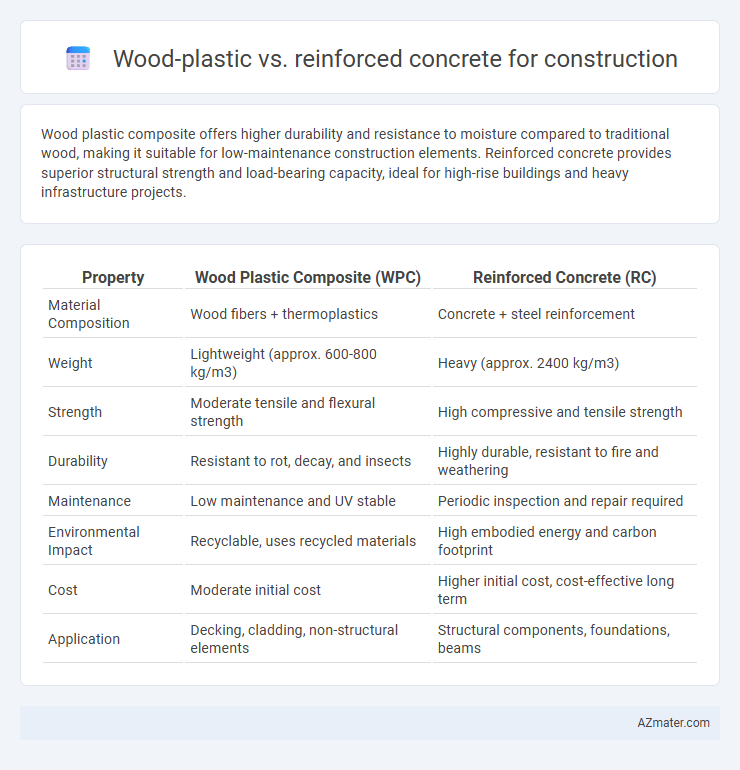Wood plastic composite offers higher durability and resistance to moisture compared to traditional wood, making it suitable for low-maintenance construction elements. Reinforced concrete provides superior structural strength and load-bearing capacity, ideal for high-rise buildings and heavy infrastructure projects.
Table of Comparison
| Property | Wood Plastic Composite (WPC) | Reinforced Concrete (RC) |
|---|---|---|
| Material Composition | Wood fibers + thermoplastics | Concrete + steel reinforcement |
| Weight | Lightweight (approx. 600-800 kg/m3) | Heavy (approx. 2400 kg/m3) |
| Strength | Moderate tensile and flexural strength | High compressive and tensile strength |
| Durability | Resistant to rot, decay, and insects | Highly durable, resistant to fire and weathering |
| Maintenance | Low maintenance and UV stable | Periodic inspection and repair required |
| Environmental Impact | Recyclable, uses recycled materials | High embodied energy and carbon footprint |
| Cost | Moderate initial cost | Higher initial cost, cost-effective long term |
| Application | Decking, cladding, non-structural elements | Structural components, foundations, beams |
Introduction to Wood Plastic and Reinforced Concrete
Wood plastic composites (WPC) combine natural wood fibers with thermoplastic materials, offering enhanced durability, resistance to moisture, and low maintenance in construction applications. Reinforced concrete integrates steel reinforcement bars within concrete to significantly increase tensile strength, making it a fundamental material for structural frameworks in buildings and infrastructure. Both materials serve distinct purposes, with WPC favored for aesthetic and lightweight applications, while reinforced concrete is essential for load-bearing and long-span structures.
Material Composition and Properties
Wood plastic composites (WPC) consist primarily of recycled wood fibers blended with thermoplastics like polyethylene or polypropylene, offering lightweight, moisture-resistant, and flexible properties ideal for decking and cladding. Reinforced concrete combines cement, aggregates, water, and steel reinforcement, delivering high compressive strength, durability, and excellent load-bearing capacity essential for structural elements like beams, columns, and foundations. The key distinction lies in WPC's resistance to rot and corrosion versus reinforced concrete's superior strength and fire resistance for long-term structural performance.
Structural Strength and Durability Comparison
Wood plastic composites (WPC) offer moderate structural strength, suitable for light to medium load-bearing applications, while reinforced concrete provides superior compressive strength and load-bearing capacity ideal for heavy structural demands. Reinforced concrete exhibits exceptional durability against environmental factors such as moisture, fire, and pests, whereas WPC is resistant to rot and insect damage but may degrade under prolonged UV exposure and heavy mechanical stress. Concrete's longevity, often exceeding 50 years in construction, surpasses WPC, which typically requires maintenance or replacement within 20-30 years.
Environmental Impact and Sustainability
Wood plastic composites (WPC) offer significant environmental benefits over reinforced concrete by utilizing recycled plastic and wood fibers, reducing landfill waste and demand for virgin materials. Reinforced concrete production is energy-intensive and releases substantial CO2 emissions, contributing heavily to global carbon footprints. WPC's biodegradability potential and lower embodied energy make it a more sustainable option for eco-conscious construction projects.
Cost Analysis and Economic Viability
Wood plastic composites (WPC) generally offer lower initial costs compared to reinforced concrete (RC), primarily due to reduced material and labor expenses. WPC's lightweight nature reduces transportation and installation fees, enhancing its economic viability for large-scale projects requiring cost-efficiency. Reinforced concrete, while more expensive upfront, provides superior durability and lower long-term maintenance costs, potentially balancing the total lifecycle cost in infrastructure with high load demands.
Construction Speed and Ease of Installation
Wood plastic composites (WPC) offer faster construction speeds due to their lightweight nature and pre-fabricated modular designs, significantly reducing on-site labor time compared to reinforced concrete. Reinforced concrete requires extended curing periods and heavy machinery for installation, leading to longer project timelines and increased logistical complexity. The ease of installation with WPC results in lower labor costs and quicker project completion, making it a preferred choice in time-sensitive construction projects.
Maintenance Requirements and Longevity
Wood plastic composites (WPC) require less maintenance compared to reinforced concrete, as they are resistant to rot, corrosion, and insect damage, reducing the need for frequent repairs or surface treatments. Reinforced concrete offers superior longevity, often exceeding 50 years, but demands regular inspections for cracks and corrosion in steel reinforcement to prevent structural degradation. Maintenance efforts for reinforced concrete typically involve sealing, patching, and cathodic protection, whereas WPC mainly requires cleaning and occasional surface refinishing to maintain appearance and performance.
Aesthetic Flexibility and Design Possibilities
Wood plastic composites offer superior aesthetic flexibility compared to reinforced concrete, enabling designers to achieve various textures, colors, and finishes that mimic natural wood or other materials. Reinforced concrete provides robust structural integrity but is limited in design versatility, often requiring additional treatments or cladding to enhance visual appeal. The adaptability of wood plastic composites in customizable shapes and modular forms supports innovative architectural expressions, making them ideal for projects prioritizing design possibilities.
Safety, Fire Resistance, and Weather Performance
Wood plastic composites (WPC) offer enhanced resistance to moisture and insects compared to traditional wood, but they generally have lower fire resistance and load-bearing capacity than reinforced concrete. Reinforced concrete provides superior structural safety, exceptional fire resistance with slow heat conduction, and excellent durability against harsh weather conditions including wind, rain, and extreme temperatures. For construction projects demanding high safety standards, fire resistance, and long-term weather performance, reinforced concrete remains the preferred material.
Applications and Suitability for Different Projects
Wood plastic composites (WPC) excel in applications requiring lightweight, moisture-resistant materials suitable for decking, cladding, and landscaping in residential or light commercial projects. Reinforced concrete offers superior structural strength and durability, making it ideal for heavy-load-bearing constructions such as bridges, high-rise buildings, and infrastructure projects. The choice depends on project requirements: WPC suits aesthetic, low-maintenance needs, while reinforced concrete is preferred for high-stress, long-lasting structural elements.

Infographic: Wood plastic vs Reinforced concrete for Construction
 azmater.com
azmater.com